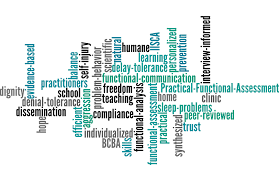
Does your child get into trouble in class? Are trips to the principal’s office common but unproductive? If so, you might be curious about new ways to address your child’s behavior. It may be time to ask the school to conduct a functional assessment, also known as a functional behavior assessment (FBA).
What a Functional Assessment Is?
A functional assessment is an approach to figuring out why your child acts a certain way. It uses a variety of techniques to understand what’s behind inappropriate behaviors. This includes looking at non-academic factors that might be contributing to your child’s frustration with learning.
Knowing what’s behind inappropriate behavior can help you and the school find ways to change the behavior. The basic idea behind this approach is that your child’s behavior serves a purpose. Whether he’s aware of it or not, your child acts a certain way to get to a desired outcome or goal.
For example, perhaps your child has a hard time showing his work on math problems. In math class, he gets angry, crumples up the paper and is disruptive. He’s sent to the principal’s office.
The behavior isn’t appropriate, but it served its purpose. Your child managed to avoid doing the work that was frustrating him. He may not know that was his goal, but he found a way to deal with the math that was causing him stress.
A key part of a functional assessment is figuring out what triggers certain behaviors in your child at home, in school and with friends. Sometimes parents and teachers assume they know what’s causing a child’s behavior because they’ve seen other children do similar things. But it’s important to remember that the causes for the same behavior can vary widely among children.
Functional Assessment vs. Comprehensive Evaluation
A functional assessment has a narrower focus than a comprehensive assessment. It focuses on the why, how, where, when and what of your child’s behavior. A comprehensive evaluation is a process that’s used to see if your child is eligible for special education services. It looks at all aspects of your child’s learning. If behavior is a concern, a functional assessment may be part of the comprehensive evaluation process.
The Functional Assessment Team
Assessment is a team effort. Each team member sees your child from a different perspective. Everyone works together to figure out what’s going on with your child’s behavior.
The assessment team varies from school to school. It typically includes a person with specialized training, such as a school psychologist or behavior specialist. That professional helps to gather information. She interviews people who know and work with your child. She will also speak with your child and do some screenings or assessments.
A functional assessment team might also include:
- General education teachers
- Special education teachers
- Professionals who work with your child (counselors and speech therapists, for example)
- School administrators
- Parents and caregivers
- Your child
The Steps of a Functional Assessment
During a functional assessment, the team gathers information and uses it to create a plan to help your child behave in more appropriate ways. Here are the steps the team takes.
Step #1: Defining the inappropriate behavior.
Using vague words to describe your child’s behavior can make it harder to gather the best information. Saying that your child is “disruptive” doesn’t give enough information. And it could mean different things to different people.
Instead, it’s important to describe the behavior in an objective, specific way. For example, you or a teacher might say that your child “rips up, throws work papers and is argumentative when asked to show work in math class.”
Step #2: Collecting, comparing and analyzing information.
This is several steps rolled into one. Team members work to pull together information from your child’s records, interviews and questionnaires. Their goal is to answer questions like:
- Where is this behavior happening?
- Where is it not happening?
- How often is the behavior occurring?
- Who is around when it occurs?
- What tends to happen right before and right after the behavior?
- What is a more acceptable behavior that can be used as a replacement?
An ABC chart is a tool that’s frequently used in this step. A stands for Antecedent (what happens before), B is for Behavior (the action or reaction), and C is for Consequence (what happens after).
Your child can help provide this information, too. Only he can tell you how he feels in these situations. Asking him to try to keep track of what he is feeling—and when—could help the team.
Step #3: Hypothesizing reasons for the behavior.
A hypothesis is a best guess based on the information you have. The team works together to figure out what your child’s behavior is telling them. What does he get out of ripping up his paper and being disruptive? It’s the team’s job to figure out what he is escaping, avoiding or getting from the behavior.
Step #4: Developing a plan.
Once the team has an idea of the reasons behind your child’s inappropriate behavior, the team works closely with the behavior specialist or psychologist to find ways to see if the hypothesis is right. This means changing something in the environment to see if it changes the behavior.
To do this, they create a behavior intervention plan behavioral intervention plan (BIP). A BIP is a plan that’s designed to teach and reward positive behaviors. This can help prevent or stop problem behaviors in school. For example, it might be helpful to see how your child acts when he’s asked to explain the steps of a math problem out loud—but not in front of the whole class. Or he could show his work on some of the problems but not all of them. Suggestions in the plan may include:
- Changes to the physical environment
- Changes to the way information is taught or presented
- Changes to your child’s routine or events that happen before the inappropriate behavior
- Changes to the consequences for a behavior
- Teaching different, more appropriate behaviors that serve the same purpose (such as asking for help or taking a break when frustrated with math)
Before putting a plan into place, the team has to make sure your child understands the expectations. They have to be sure he can control the inappropriate behavior and is motivated to change. This is where information from a comprehensive evaluation is helpful.
The Role of Parents in a Functional Assessment
Knowing that your child’s behavior is causing problems can bring up many feelings. But the team is trying to work together to find solutions—not to place blame. Tell the team what you’re seeing at home. This is an important piece of this process. It can show the similarities and differences between your child at home and at school. You can keep track of your child’s behavior using an ABC approach or by keeping a journal. Taking notes can make it easier to see patterns in your child’s behavior.
A functional assessment may not provide an immediate solution to your child’s behavior issues. But it can give a more complete picture of your child’s struggles. Then you and the school can work together to take the next steps to help your child.
A functional behavior assessment (FBA) can help figure out the cause of problem behaviors. A behavior intervention plan (BIP) is a plan that’s based on the FBA. A BIP can help to replace problem behaviors with more positive ones. Here’s what you need to know about behavior interventions and the BIP.
What Are Behavior Interventions?
Behavior interventions are steps teachers take to stop problem behaviors at school. First, the problem behavior must be identified. For example, your child may be:
- Disrupting the class
- Showing aggression toward the teacher or other children
- Acting unresponsive or withdrawn
- Refusing to do classroom work
- Using inappropriate or harassing language
Your child’s teacher or IEP team can work to determine what purpose the problem behavior serves for your child. For example, there are many possible reasons why he throws a book in class. Maybe he can’t understand what’s being taught.
What does your child gain or avoid by misbehaving? Maybe he’s seeking attention from the teacher or other students. Kids often don’t know why they do what they do. By doing a functional behavior assessment (FBA), the IEP team or teachers and staff can determine the cause of the behavior. Then they can plan appropriate ways for your child to seek attention.
The FBA may involve interviewing your child, the teacher or other school staff. The teacher and other staff may also observe your child to pinpoint what triggers the problem behavior. Once the IEP team understands what function the behavior serves for your child, they can create a behavior intervention plan.
What Is a Behavior Intervention Plan?
A behavior intervention plan (BIP) is a plan that’s designed to teach and reward positive behaviors. This can help prevent or stop problem behaviors in school. The BIP is based on the results of the FBA.
The BIP describes the problem behavior, the reasons the behavior occurs and the intervention strategies that will address the problem behavior.
The IEP team might realize that your child lacks the skills needed to handle certain situations. For example, if your child has attention and impulsivity issues, he may not know how to respond appropriately when another child confronts him. Instead, he might become physically aggressive.
A BIP can help your child learn problem-solving skills and better ways to respond in that type of situation. The plan also explains who is responsible for helping with each aspect of the BIP. Here’s how that might read in a BIP:
- The student will ask for breaks when needed.
- The counselor will teach student self-calming activities.
- The student will be removed from a group after one warning until he can show self-control.
- The student will be rewarded with computer time if the teacher notices him working well in a group.
- The teacher will de-emphasize competition in classroom.
What to Watch Out For?
A child’s BIP should be monitored and adjusted as needed. A BIP doesn’t always work as planned. Two of the most common reasons are:
- A mismatch between the intervention and the targeted behavior. Sometimes the IEP team assumes the misbehavior happens for one reason, but the real reason is something else completely.
- A failure to monitor and adjust the rewards or reinforcement for appropriate behavior over time. What works at first might soon become “old hat” and need to be switched up.
Problem behavior can be triggered by things that are unrelated to children’s learning and attention issues. It can be caused by frustration with school, family issues or social pressure. Even the size of a classroom or nearby distractions can set off inappropriate behavior.


